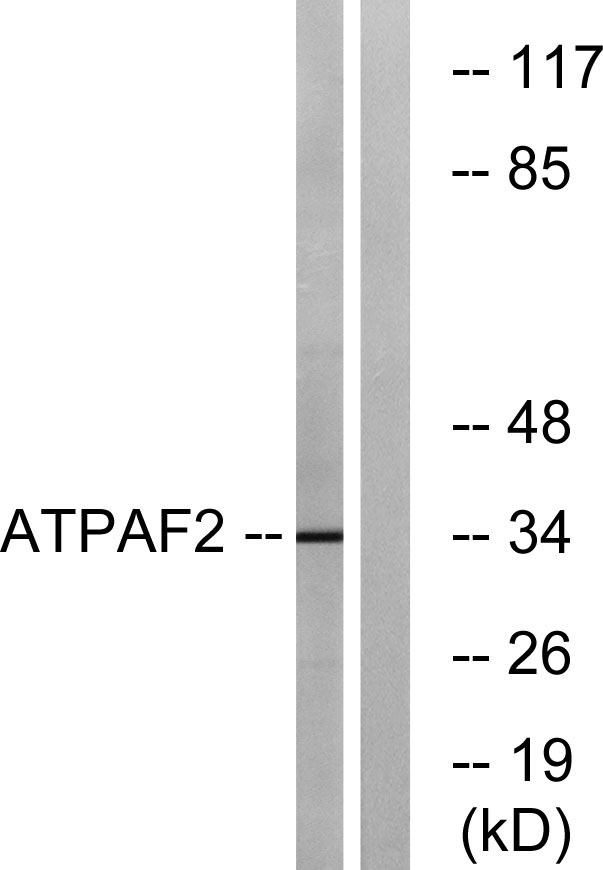ATPAF2 Polyclonal Antibody
- Catalog No.:YT0413
- Applications:WB;ELISA
- Reactivity:Human;Mouse
- Target:
- ATPAF2
- Gene Name:
- ATPAF2
- Protein Name:
- ATP synthase mitochondrial F1 complex assembly factor 2
- Human Gene Id:
- 91647
- Human Swiss Prot No:
- Q8N5M1
- Mouse Gene Id:
- 246782
- Mouse Swiss Prot No:
- Q91YY4
- Immunogen:
- The antiserum was produced against synthesized peptide derived from human ATPAF2. AA range:21-70
- Specificity:
- ATPAF2 Polyclonal Antibody detects endogenous levels of ATPAF2 protein.
- Formulation:
- Liquid in PBS containing 50% glycerol, 0.5% BSA and 0.02% sodium azide.
- Source:
- Polyclonal, Rabbit,IgG
- Dilution:
- WB 1:500 - 1:2000. ELISA: 1:40000. Not yet tested in other applications.
- Purification:
- The antibody was affinity-purified from rabbit antiserum by affinity-chromatography using epitope-specific immunogen.
- Concentration:
- 1 mg/ml
- Storage Stability:
- -15°C to -25°C/1 year(Do not lower than -25°C)
- Other Name:
- ATPAF2;ATP12;LP3663;ATP synthase mitochondrial F1 complex assembly factor 2;ATP12 homolog
- Observed Band(KD):
- 35kD
- Background:
- ATP synthase mitochondrial F1 complex assembly factor 2(ATPAF2) Homo sapiens This gene encodes an assembly factor for the F(1) component of the mitochondrial ATP synthase. This protein binds specifically to the F1 alpha subunit and is thought to prevent this subunit from forming nonproductive homooligomers during enzyme assembly. This gene is located within the Smith-Magenis syndrome region on chromosome 17. An alternatively spliced transcript variant has been described, but its biological validity has not been determined. [provided by RefSeq, Jul 2008],
- Function:
- disease:Defects in ATPAF2 are the cause of complex V mitochondrial respiratory chain ATPAF2 subunit deficiency (ATPAF2 deficiency) [MIM:604273]; also called ATP synthase deficiency or ATPase deficiency. ATPAF2 deficiency seems to be an early presenting disease in which lactic acidosis, dysmorphic features, and methyl glutaconic aciduria can be major clues in the diagnosis. Dysmorphic features include a large mouth, prominent nasal bridge, micrognathia, rocker-bottom feet and flexion contractures of the limbs associated with camptodactyly. Patients are hypertonic and have an enlarged liver, hypoplastic kidneys and elevated lactate levels in urine, plasma and cerebro spinal fluid (CSF).,function:May play a role in the assembly of the F1 component of the mitochondrial ATP synthase (ATPase).,similarity:Belongs to the ATP12 family.,subunit:Interacts with ATP5A1.,tissue specificity:Widely expr
- Subcellular Location:
- Mitochondrion .
- Expression:
- Widely expressed.
- June 19-2018
- WESTERN IMMUNOBLOTTING PROTOCOL
- June 19-2018
- IMMUNOHISTOCHEMISTRY-PARAFFIN PROTOCOL
- June 19-2018
- IMMUNOFLUORESCENCE PROTOCOL
- September 08-2020
- FLOW-CYTOMEYRT-PROTOCOL
- May 20-2022
- Cell-Based ELISA│解您多样本WB检测之困扰
- July 13-2018
- CELL-BASED-ELISA-PROTOCOL-FOR-ACETYL-PROTEIN
- July 13-2018
- CELL-BASED-ELISA-PROTOCOL-FOR-PHOSPHO-PROTEIN
- July 13-2018
- Antibody-FAQs
- Products Images

- Western Blot analysis of various cells using ATPAF2 Polyclonal Antibody

- Western blot analysis of lysates from Jurkat cells, using ATPAF2 Antibody. The lane on the right is blocked with the synthesized peptide.



